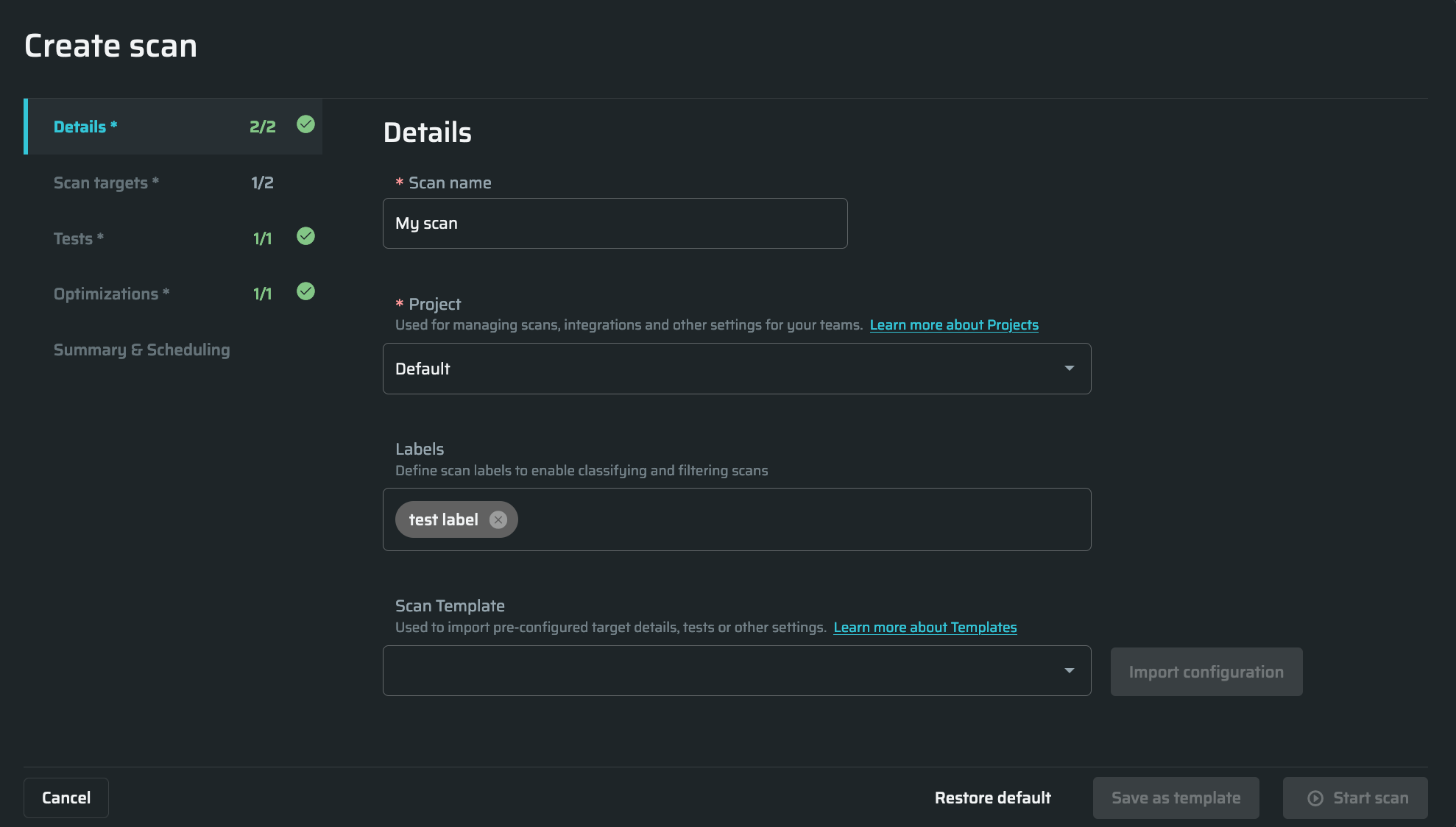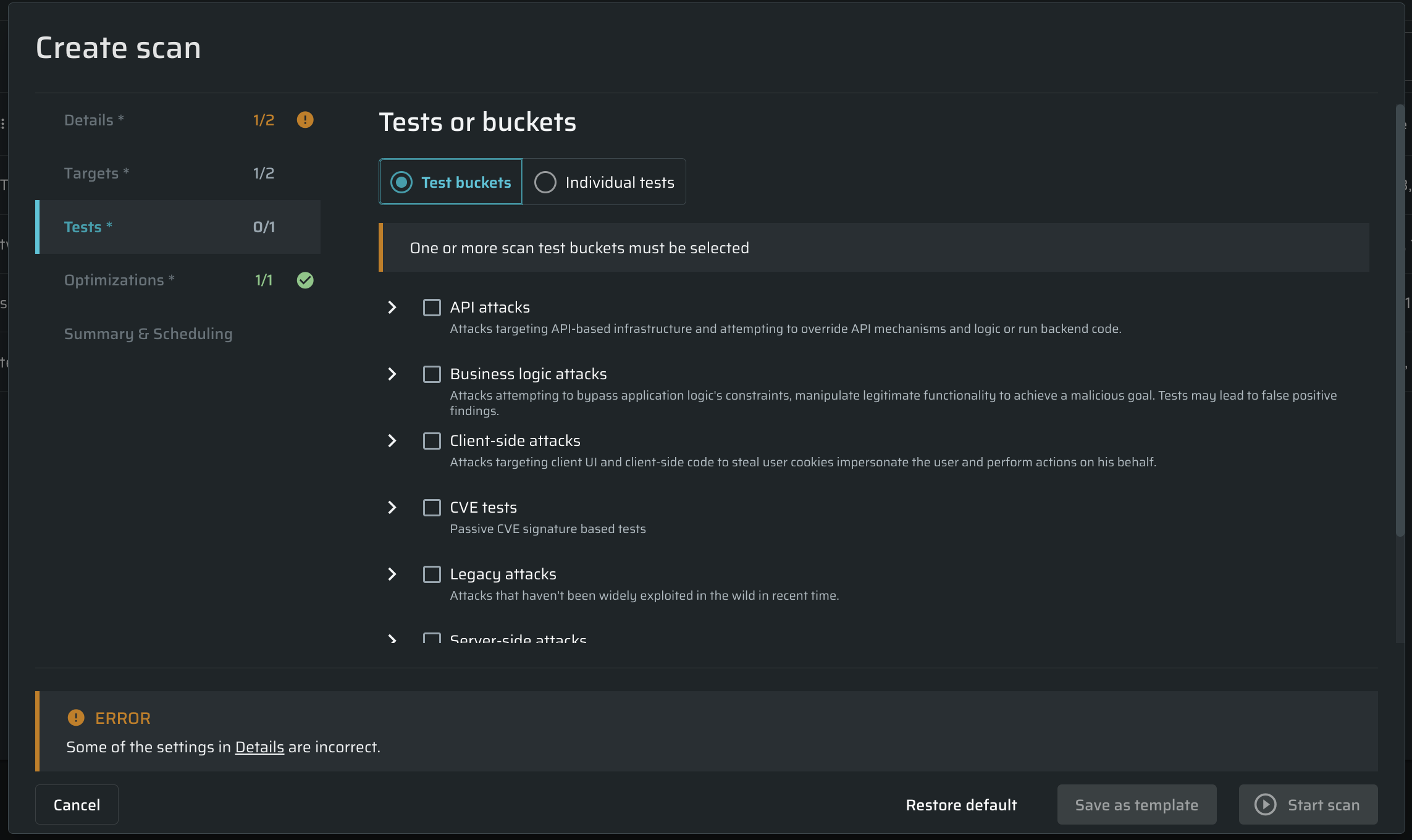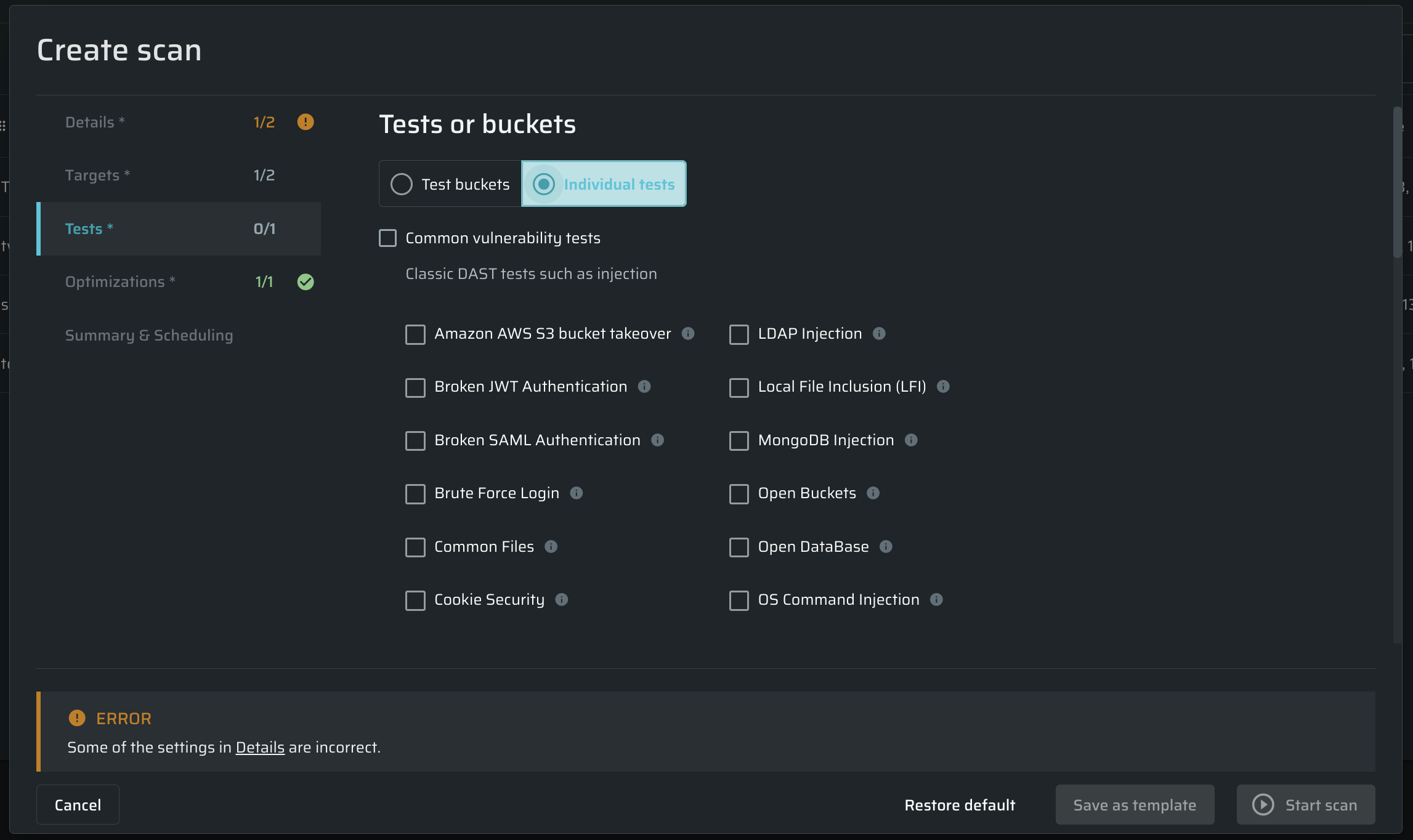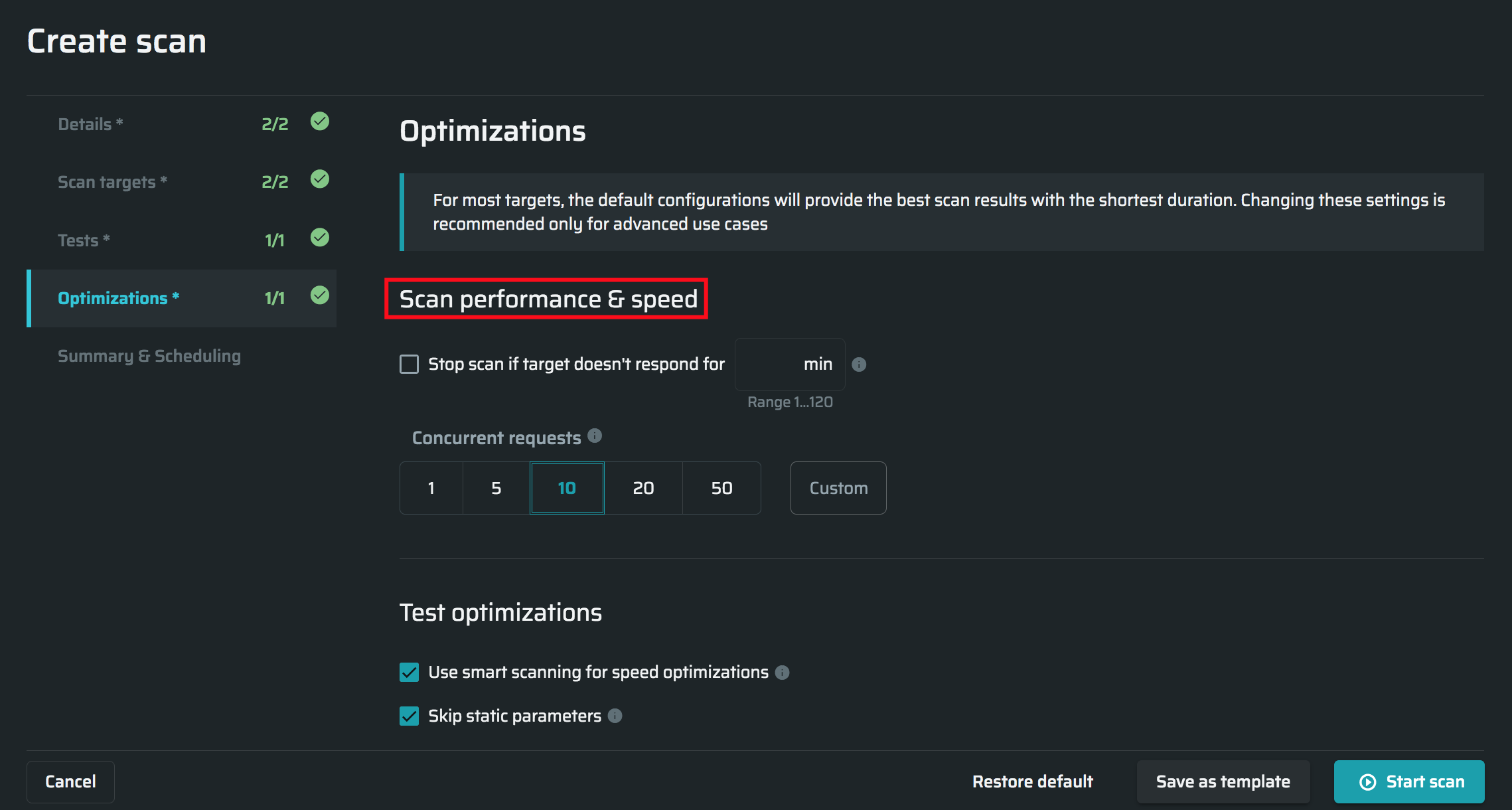Creating a Scan
This page describes a creation of modern scan, which uses advantages of persistent Entrypoints. To run a security scan against a target, follow these steps:
- In the left pane, select the Scans option to see the list of available scans.
- In the Scans pane, click Create scan to create a new scan.

Specifying scan details
In the Details tab, do the following:
- In the Scan name field, enter any free-text name for the scan.

- From the Project dropdown list, select the Bright project you want to use for the scan.
Note:You can start a scan only with a project selected. If you do not have any projects in Bright, select the Default one.
- Bright allows users to mark any scans to simplify work with them. Labels can be added in this field, separated by commas. All the added labels will be displayed on the Scans page and on the Configuration tab in the Scan info page. If there is an existing label from previous scans, start to type it, and then choose from the autocompleted form below.
Semicolons and commas are used to separate labels, so It is not allowed to use them in label names. For one scan it is possible to add up to 15 labels, each of them can be up to 255 symbols in length. The ability to add or/and remove labels is limited toscans,scan:run, andscan:managescopes.Note:It is allowed to change the scan labels after the scan creation on a Scan editing page
- (Optional). Bright provides a list of preconfigured scan templates to help users assess their vulnerabilities quicker and more efficiently. The list is available in the Scan Template. Click Import configuration to apply changes. You also can create a template to apply frequently used scan configurations. For further details, see Managing Scan Templates. We recommend initially using the Light Scan template to test target connectivity and performance, and only then customize a Scan further.
Note:Please note that templates may have locked settings which are unavailable for editing when the scan is being created. To update such settings, you should have access to the template. To learn more about templates, see this article.
Defining scan targets
To define scan targets, do the following:
- Open the Scans page and click the + Create scan button at the top of the page.
- Open the Targets tab and choose Select the known Entrypoints from the Project option.
- Click the + Select Entrypoints button
- A Scope selector will appear, which is a table of discovered Entrypoints. This table is unified with the others in the Bright app, so you can adjust it or use filters. For instance, you can sort entrypoints by its connectivity to add only those which have OK status.
- Click Save & Close button to apply changes.
Choose repeater (this option is available only if the "On a private network or not authorized" type is selected) - From the dropdown menu if there are existing ones. To know how to create a new repeater, Learn more about Repeater Mode
Selecting test for a scan
In the Scan Tests tab, you can do the following:
- Use the Test buckets section, to select the appropriate tests from the pre-configured buckets.

All tests are divided into the following buckets:- API attacks - Attacks targeting API-based infrastructure and attempting to override API mechanisms and logic or run backend code.
- Business logic attacks - Attacks attempting to bypass application logic's constraints, manipulate legitimate functionality to achieve a malicious goal. Tests may lead to false positive findings.
- Client-side attacks - Attacks targeting client UI and client-side code to steal user cookies impersonate the user and perform actions on his behalf.
- CVE attacks - Passive CVE signature based tests
- Legacy attacks - Attacks that haven't been widely exploited in the wild recently.
- Server-side attacks - Attacks trying to exploit server-side architecture and code.
- Advanced / Harmful attacks - Attacks potentially causing a temporary disruption to the backend infrastructure. Use with caution and don’t target against production environments.
- If you want to select tests manually, open the Individual tests section, and choose the tests to be performed during the scan by checking their checkboxes.

NoteFor details on vulnerabilities that can be detected by Bright, see Vulnerability Guide.
- Business-logic vulnerability tests - Advanced, context-specific tests that look for non-trivial vulnerabilities such as using legitimate app flows in a way that results in a negative consequence to the organization, such as stolen user data.
- Third-party tests - Using third-party tools to find known vulnerabilities (CVEs) in the target.
- Lack of Resources and Rate-Limiting test - Tests all API endpoints for rate-limiting or resource exhaustion protection in place. This test is mutually exclusive with other tests.
Configuring optimizations settings
Scan performance and speed
Stop scan, if the target does not respond – Set a limit to response duration for the scan target globally. If the specified duration is exceeded, the scan will be stopped automatically. The default value is 5 min.
Concurrent requests - Specify the maximum concurrent requests allowed to be sent by the scan in order to control the load on your server. The default value is 10 requests.
Note:To fix the issue, when a scan is getting into disrupted state for no obvious reason, restart the scan and change the scan setting, uncheck the option Stop scan if target doesn’t respond for ... min, and then click Retest scan.
While we’re working on optimization of the setting, use this note to prevent the issue.

Test optimizations
Use smart scanning for speed optimizations - Specify whether to use automatic smart decisions (such as parameter skipping, detection phases, and so on) in order to minimize scan time. When this option is turned off, all tests are run on all the parameters, which increases coverage at the expense of scan time. Learn more about Smart scanning.
Skip static parameters - Specify whether to skip static parameters to minimize scan time. Learn more about Static parameters.
Skip parameters by patterns - You can define which parameters you want to skip in order to improve scan time. Learn more about Skipping parameters.
Target parameter locations - Settings are used to manually point the scanner which parts of the request (address) to attack.
In most cases, this is enough to provide a high-quality scan. Select all available options if you want the deepest scan and don't care about the long scan time. In this case, the scanner will check all parts of the request (address), which will significantly increase the scanning time. In some cases, this can improve scan results. Learn more about Target parameter locations.

Summary and scheduling
Run a scan now - Choose this option to start the scan immediately.
Schedule a single scan for later - Select a date and time to schedule the scan to run once automatically.
Create a recurrent scan – Define the frequency and schedule of the scan to run repeatedly and automatically.

Starting a scan
Once you complete the setup, you can run the scan immediately or save it as a template. The template will be saved to the templates list in the Templates tab. You can select any template when creating a new scan.
- Click Save as Template to save the scan template.
- Click Start Scan to run the preconfigured scan immediately.
NoteIf the maximum number of scans that can be run simultaneously is exceeded, the scan is placed in the queue. The concurrent scans limitation can be set either for the entire organization or for this particular project in the project settings. The new scan will start as soon as you manually stop another running scan or when the current scan is completed.
You can also use the Restore Default button to reset the custom settings.
Updated about 2 months ago
